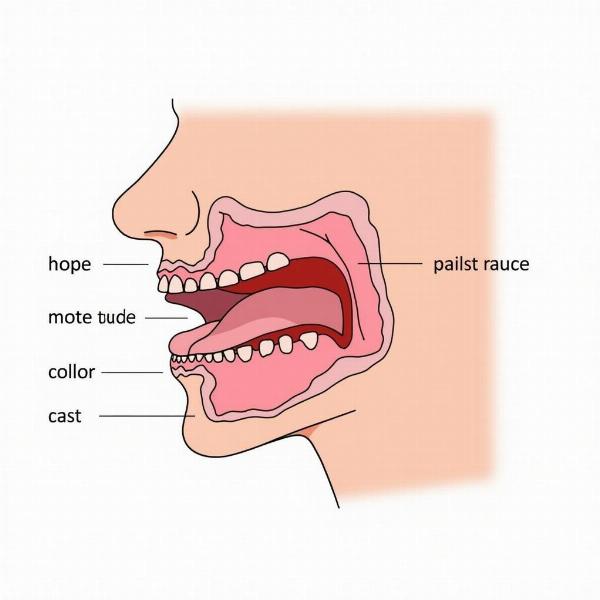Talaffuz, meaning pronunciation in Hindi, is crucial for effective communication. Whether you’re learning Hindi, teaching it, or simply looking to improve your spoken Hindi, understanding the nuances of talaffuz can greatly enhance your ability to connect with others. This article delves into the significance of talaffuz, explores common pronunciation challenges, and provides practical tips for mastering the art of speaking Hindi clearly and confidently.
The Importance of Talaffuz in Hindi
Correct talaffuz is the cornerstone of clear communication in Hindi. Mispronouncing words can lead to misunderstandings, create awkward situations, and even change the meaning of what you’re trying to say. Imagine saying “kal” (tomorrow) instead of “kaal” (yesterday)! The consequences can be significant. Mastering talaffuz demonstrates respect for the language and culture, enabling you to build stronger relationships with Hindi speakers.
Common Challenges in Hindi Pronunciation
Hindi pronunciation can be tricky for non-native speakers due to its unique sounds and retroflex consonants. The aspirated and unaspirated consonants, such as “k” and “kh,” “t” and “th,” pose a particular challenge. Furthermore, the nasal sounds, represented by the anusvara (ं) and chandrabindu (ँ), can be difficult to differentiate and articulate correctly.
Mastering the Retroflex Consonants
The retroflex consonants, like “ट” (ṭ), “ठ” (ṭh), “ड” (ḍ), “ढ” (ḍh), and “ण” (ṇ), are formed by curling the tongue back towards the roof of the mouth. This can be a significant hurdle for those unfamiliar with these sounds.
 Diagram illustrating the tongue position for retroflex consonants.
Diagram illustrating the tongue position for retroflex consonants.
Differentiating Aspirated and Unaspirated Consonants
Understanding the difference between aspirated and unaspirated consonants is key. Aspirated consonants are pronounced with a puff of air, while unaspirated consonants are not. For example, “क” (k) is unaspirated, while “ख” (kh) is aspirated.
Practical Tips for Improving Your Talaffuz
- Listen Actively: Immerse yourself in Hindi by listening to native speakers, watching Hindi movies, and listening to Hindi music.
- Practice Regularly: Consistent practice is crucial. Repeat words and phrases aloud, paying close attention to the subtle differences in sounds.
- Record Yourself: Recording yourself speaking Hindi allows you to identify areas for improvement and track your progress.
- Seek Feedback: Ask native speakers for feedback on your pronunciation. They can provide valuable insights and corrections.
- Use Online Resources: Utilize online pronunciation guides, dictionaries, and language learning apps.
Focus on Intonation and Stress
Intonation and stress play a vital role in conveying meaning in Hindi. Paying attention to these aspects can significantly improve your overall talaffuz.
Conclusion
Mastering talaffuz in Hindi requires dedication and practice, but the rewards are immense. By understanding the nuances of pronunciation, you can communicate more effectively, build stronger relationships, and deepen your appreciation for the Hindi language and culture. So, embrace the challenge and embark on your journey towards perfect talaffuz!
FAQ
- What does talaffuz mean in Hindi? Talaffuz means pronunciation.
- Why is talaffuz important? Correct talaffuz is essential for clear communication and understanding.
- What are some common pronunciation challenges in Hindi? Retroflex consonants and aspirated/unaspirated consonants are common challenges.
- How can I improve my talaffuz? Active listening, regular practice, recording yourself, and seeking feedback are helpful.
- Where can I find resources to help me with Hindi pronunciation? Online dictionaries, pronunciation guides, and language learning apps are great resources.
- What is the difference between “kal” and “kaal”? “kal” means tomorrow, while “kaal” means yesterday.
- How do I pronounce retroflex consonants? Retroflex consonants are produced by curling the tongue back towards the roof of the mouth.
Meaning-Hindi.in is your one-stop solution for all your Hindi translation needs. We offer a wide range of professional translation services, including business and commercial document translation, certified and legal document translation, technical and user manual translation, website and localization translation, educational and academic document translation, express translation, and specialized translation. Looking for accurate and reliable Hindi translations? Contact us today at [email protected] or call us at +91 11-4502-7584. Meaning-Hindi.in is committed to delivering high-quality translations that bridge language barriers and facilitate effective communication.